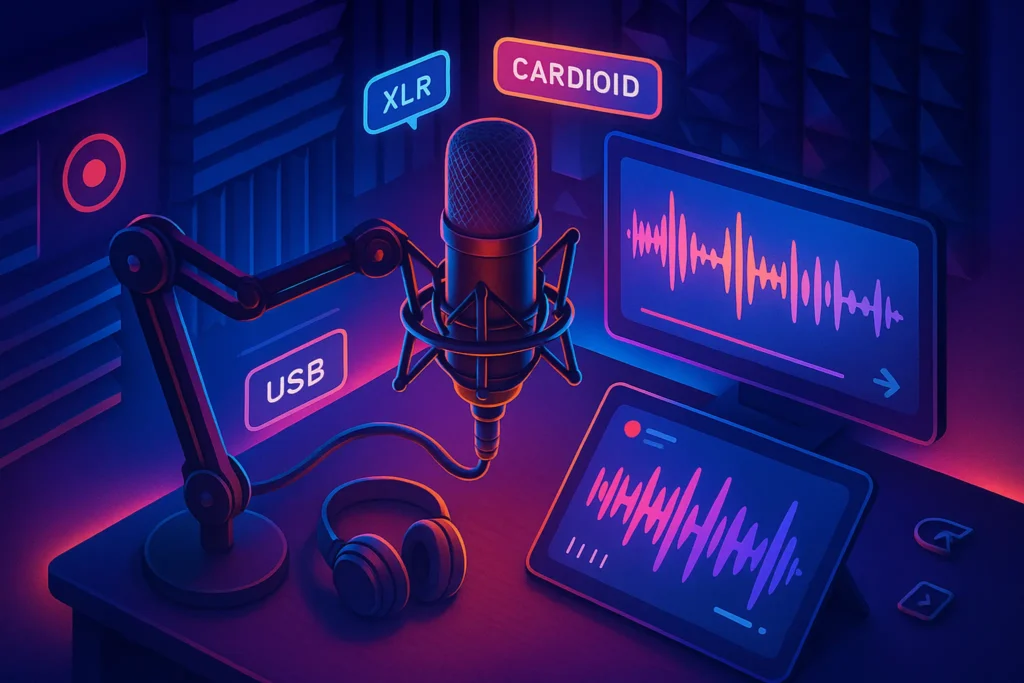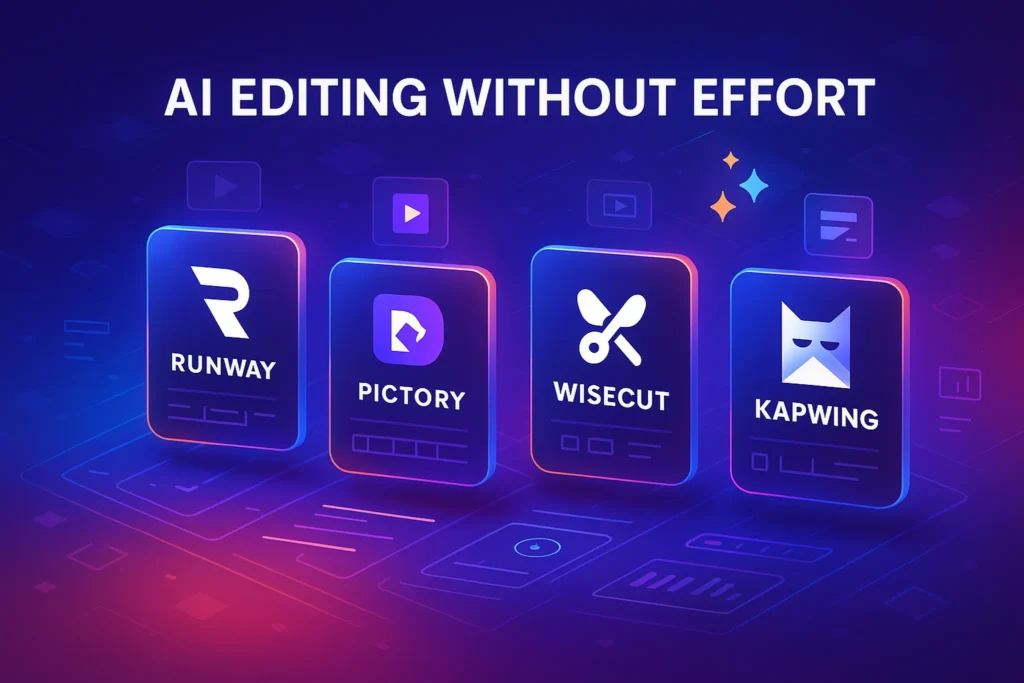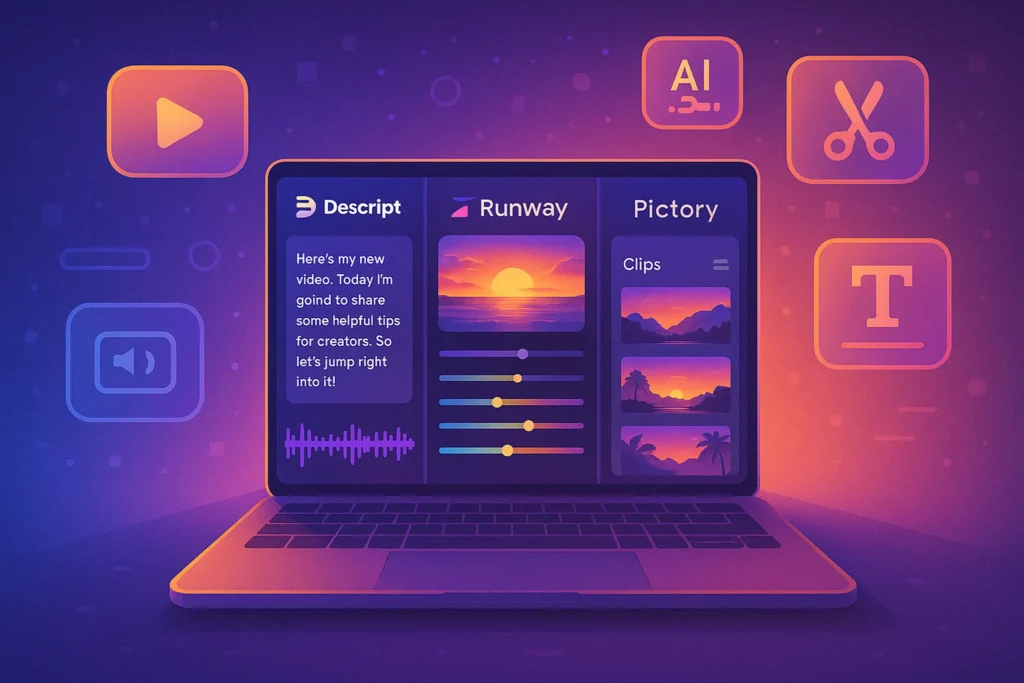🎧 Introduction: Why Audio Quality Is Non-Negotiable
Whether you’re podcasting, streaming, or creating YouTube tutorials, one thing separates amateur content from pro-grade production — sound quality. Viewers might forgive mediocre visuals, but they won’t stick around for distorted, echoey, or muddy audio.
Luckily, you don’t need a recording studio to sound polished. With the right mic — even on a budget — you can dramatically improve clarity, reduce background noise, and sound more professional from day one.
In this guide, we’ll break down:
-
The key differences between USB vs XLR and dynamic vs condenser mics
-
Top mic recommendations for every budget
-
Use-case-based suggestions (voiceover, livestreams, mobile setups)
-
Simple tips to instantly upgrade your sound
Let’s help you pick the perfect microphone — one that fits your style, space, and content goals.
🎙️ What to Look for in a Podcast/Video Mic
Choosing the right microphone can feel overwhelming, but understanding a few core factors makes the decision much easier — especially if you’re creating podcasts, tutorials, livestreams, or voiceovers.
Here’s what to evaluate before you buy:
1. Connection Type (USB vs XLR)
USB mics are plug-and-play and ideal for beginners or solo creators. XLR mics need an audio interface but deliver better quality and flexibility.
2. Pickup Pattern
Most creators use cardioid pattern mics, which capture sound from the front while reducing background noise. For interviews or multi-directional recordings, look for multi-pattern options.
3. Mic Type (Dynamic vs Condenser)
-
Dynamic mics reject background noise well — great for untreated rooms or streaming.
-
Condenser mics offer more clarity and detail — perfect for voiceovers and studio use.
4. Mounting Setup
Some mics come with desk stands, while others are better with a boom arm + shock mount for better positioning and vibration isolation.
🎯 If you’re just starting out, focus on mics with USB, cardioid pickup, and built-in gain control — they offer great results with minimal fuss.
Before diving into specific models, it’s important to understand the basic terms that will shape your decision:
🔌 USB vs XLR — Which One Should You Choose?
Both USB and XLR microphones have their place. The choice depends on your current skill level, setup, and scalability needs.
🟢 USB Microphones
-
Pros: Plug-and-play, no extra gear required, perfect for beginners
-
Cons: Limited upgrade options, less depth than XLR
-
Best For: Solo podcasters, streamers, mobile setups, digital nomads
🔴 XLR Microphones
-
Pros: Superior audio fidelity, professional-level control and expansion
-
Cons: Requires an interface or mixer, more expensive
-
Best For: Multi-host podcasts, voiceover artists, professional studios
⚖️ Start with USB if you’re new or mobile. Move to XLR as your skills and production scale up.
-
USB Mics are plug-and-play. They connect directly to your computer and are perfect for beginners or solo creators.
-
XLR Mics require an audio interface or mixer. They offer better sound fidelity and upgrade potential, ideal for pro-level setups.
🔎 If you’re not ready to invest in an audio interface yet, start with USB. Many creators upgrade later once their gear or team expands.
🎚️ Dynamic vs Condenser
-
Dynamic Mics are great at rejecting background noise. Perfect for untreated rooms or livestreams.
-
Condenser Mics capture a wider frequency range and detail — great for voiceovers or studio recording.
🪟 Desktop vs Boom Mount
-
Desktop mics sit on your desk — convenient but prone to keyboard or desk noise.
-
Boom arms isolate mic movement and improve positioning. Highly recommended for long-form recording.
If you’re just starting out and want to keep your total gear spend under $200, our breakdown of Video Equipment on a Budget offers even more great starter picks.
⚖️ USB vs XLR: Side-by-Side Comparison
If you’re still deciding between USB and XLR, here’s a practical breakdown to help clarify which is right for your workflow:
| Feature | USB Mic | XLR Mic |
|---|---|---|
| 🔌 Connection | Direct to computer (plug & play) | Requires audio interface or mixer |
| 🎙️ Sound Quality | Good to very good | Excellent depth, warmth, flexibility |
| 🔁 Upgrade Options | Limited | Highly modular & scalable setup |
| 🧳 Portability | High — perfect for mobile creators | Lower — more gear to manage |
| 💵 Price Range | ~$40–$150 | $100+ + interface cost |
| 👤 Ideal Users | Solo creators, beginners, streamers | Podcast studios, voiceover pros |
🎯 Rule of thumb: Start USB if you’re solo and mobile. Move to XLR when you’re ready for advanced control and multi-mic setups.
🔊 Best Mics for Beginners (Under $100)
You don’t need to break the bank to sound professional. These beginner-friendly mics offer solid performance, ease of use, and reliable build quality — perfect for solo podcasters, online teachers, or YouTubers just starting out.
🎤 Blue Yeti (USB)
The Blue Yeti is one of the most iconic and widely used USB microphones in the creator world. Its standout feature is its multiple pickup patterns, allowing flexibility for solo voice, interviews, and ambient recording.
Why It’s Great:
-
Four pickup patterns: cardioid, omnidirectional, bidirectional, and stereo
-
Onboard controls for gain, mute, and headphone monitoring
-
Plug-and-play on both Windows and macOS — no driver needed
Ideal Use Case:
-
Podcasting, Twitch/YouTube streaming, voiceovers, multi-person interviews
📝 If you’re recording in a semi-treated room or want flexibility in mic positioning, the Blue Yeti gives you that without needing extra gear.
A classic choice for content creators. Offers multiple pickup patterns (cardioid, omnidirectional, bidirectional, stereo) with simple controls and headphone monitoring.
-
✅ Plug-and-play via USB
-
✅ Great voice clarity
-
✅ Ideal for podcasts, solo streams, or interviews
Nerd Tip: Use cardioid mode for solo recordings and reduce room noise significantly.
🎤 Samson Q2U (USB/XLR Hybrid)
The Samson Q2U is a dynamic mic that offers both USB and XLR outputs, making it one of the most future-proof mics for creators starting out but planning to scale.
Why It’s Great:
-
USB/XLR hybrid – start simple, upgrade later
-
Excellent noise rejection for home studios and untreated rooms
-
Comes bundled with a desktop stand, windscreen, and cables
Ideal Use Case:
-
Solo podcasting, streaming in noisy environments, mobile setups
✅ If you want a mic that grows with you — and works equally well plugged into a laptop or an audio interface — the Q2U is unbeatable under $100.
A versatile dynamic mic that grows with you. Use it via USB to start — then switch to XLR as your setup expands.
-
✅ Includes stand, cables, and windscreen
-
✅ Excellent noise rejection for untreated rooms
-
✅ Great for livestreams and mobile podcast kits
For creators working from shared spaces or noisy homes, the Q2U punches way above its price.
🎤 Fifine K690 (USB)
The Fifine K690 is a lesser-known but powerful budget USB condenser microphone with studio-like features at a beginner price.
Why It’s Great:
-
Clean condensed sound capture for vocals, YouTube videos, voiceovers
-
Pattern switch button: cardioid, omnidirectional, bidirectional, stereo
-
Dedicated gain dial + mute button + headphone jack
Ideal Use Case:
-
Content creators who want pro-level clarity for solo narration or multi-speaker interviews — without breaking the bank.
🎧 The K690 competes with the Blue Yeti but often comes in at a lower price — a smart buy for budget-conscious creators who care about quality.
Affordable condenser mic with professional controls: gain knob, mute button, and pattern switch.
-
✅ Superb detail for voiceovers or narration
-
✅ Budget-friendly alternative to the Blue Yeti
-
✅ Sleek design, plug-and-play simplicity
🎧 Best Mics for Intermediate to Pro Creators ($150+)
As your audience grows, so should your sound. These mics offer broadcast-level audio quality, perfect for serious creators, podcasters, and multi-guest setups.
🎙️ Shure MV7 (USB/XLR Hybrid)
The Shure MV7 is a high-performance hybrid microphone inspired by the legendary Shure SM7B — a broadcast classic used by professionals around the world. Unlike the SM7B, however, the MV7 offers USB and XLR connectivity, making it one of the most flexible microphones for modern creators.
Why It’s Great:
-
Dual-output: USB for plug-and-play, XLR for studio-level control
-
Dynamic mic design = excellent background noise rejection
-
Touch-sensitive panel for gain, volume, mute, and monitor mix
-
Companion app (ShurePlus MOTIV) lets you tweak EQ, limiter, compressor, and more
Ideal Use Case:
-
Podcasting in noisy rooms, livestreaming, YouTube voiceovers, mobile setups that may evolve into full studios
-
Great choice for creators who want studio-quality audio with plug-and-play simplicity
Inspired by the legendary Shure SM7B, but more accessible. Dual connectivity (USB and XLR), plus built-in DSP for tuning tone and gain.
-
✅ Works with mobile, desktop, or interface
-
✅ Tight cardioid pattern reduces room noise
-
✅ Great for livestreamers and interviewers
If you’re ready to level up from USB but still want flexibility, the MV7 is a powerhouse.
Bonus Tip:
If you’re planning to record both locally and for live streaming, the MV7 allows you to record via XLR while monitoring live via USB — a rare and powerful feature.
🎯 For creators who want to sound professional from day one — and keep growing without needing to switch gear — the MV7 is the perfect long-term investment.
🎙️ Rode NT1 (XLR)
The Rode NT1 is a studio-grade XLR condenser microphone with ultra-low self-noise and gorgeous detail — a favorite for voice actors, audio professionals, and high-end YouTubers.
Why It’s Great:
-
Exceptionally quiet (4.5 dBA) — one of the quietest mics in its class
-
Delivers rich vocal tone and subtle dynamics
-
Includes shock mount + pop filter in the bundle
Ideal Use Case:
-
ASMR, audiobooks, voiceover work, studio-grade podcasts
🎙️ If sound purity and vocal richness are your top priority, the Rode NT1 is hard to beat in the sub-$300 category.
A studio-grade condenser mic with ultra-low self-noise and crystal clarity. Requires interface.
-
✅ Stunning detail for vocals and instruments
-
✅ Comes with shock mount and pop filter
-
✅ Ideal for voice actors, ASMR creators, or studio podcasters
🎙️ Elgato Wave:3 (USB)
The Elgato Wave:3 is a USB condenser mic designed specifically for streamers, gamers, and video creators. It’s not just a mic — it’s an integrated digital audio control hub.
Why It’s Great:
-
Wave Link software gives control over multiple audio sources (mic, game, music)
-
Built-in clip-guard, low-latency monitoring, capacitive mute
-
Works seamlessly with OBS, Streamlabs, and Twitch setups
Ideal Use Case:
-
Streamers, gaming channels, creators who need multi-audio mixing without buying a mixer
🧠 It’s like having a mini digital mixer built into your mic — ideal for multitaskers and live producers.
Built for streamers. Combines sleek design with powerful digital mixing via Wave Link software.
-
✅ Clip-guard and real-time monitoring
-
✅ Perfect for gaming, YouTube, and Twitch
-
✅ Highly optimized for OBS and streaming platforms
For video creators who also livestream, the Wave:3 bridges quality and ease like no other.
🧠 Choosing Based on Use Case
Not every mic works well for every content format. Here’s how to pick based on what you actually do:
🎙️ Voiceovers & Narration
Go with condenser mics like the Rode NT1 or Fifine K690. They capture full frequency range and deliver rich vocal depth — great for tutorials, audiobooks, and educational videos.
🔴 Livestreaming & Gaming
Choose a dynamic mic with good noise rejection, such as the Samson Q2U or Shure MV7. These help block keyboard noise and echo from untreated rooms.
🎤 Interviews & Multi-Person Podcasts
Look for mics with multiple pickup patterns, like the Blue Yeti, or use XLR setups for separate mic control. XLR makes it easier to mix each guest’s voice independently.
🎒 Mobile or On-the-Go Recording
Use compact USB mics like the Samson Q2U or Rode VideoMic Me-L (for iPhone). Consider battery-free options that don’t require an interface.
🎯 Already using video in your work? Check out How to Script Your Videos for Maximum Engagement to pair great audio with powerful storytelling.
🎛️ Tips to Instantly Improve Sound Quality
Even the best mic won’t save you if your recording environment is poor. Here’s how to make any mic sound better:
-
🫧 Use a Pop Filter: Reduces harsh plosive sounds (like P, B) and makes your voice smoother.
-
🧼 Control Gain Levels: Avoid clipping by monitoring input levels. Too loud = distortion.
-
🪵 Treat the Room: Rugs, curtains, and foam panels reduce reverb. A cheap blanket over your desk can help more than you think.
-
🎧 Use Headphones: Monitor your voice to catch distortions or background noise early.
Want to build a full beginner setup? Our guide on Best Cameras and Mics for Beginners walks you through a high-quality kit under $300.
🎙️ Want More Gear Guides Like This?
Join our free newsletter and get weekly tech picks for creators — from microphones and cameras to AI tools and editing hacks.
🔐 No spam. Just smart tools and creator-tested recommendations.
🎧 Audio Sample Suggestion (Hear Before You Buy)
You don’t need to guess how a mic will sound — let your ears decide.
Search YouTube for real-world demos like:
-
"Blue Yeti vs Samson Q2U microphone test" -
"Shure MV7 podcast audio demo" -
"Rode NT1 vs condenser mic shootout"
These tests can help you understand tone, warmth, clarity, and how mics perform in untreated rooms.
🧰 Build-a-Kit: Best Microphone Setups by Budget
We know gear costs add up fast. Here’s how to build a smart mic setup — tailored to your current stage:
💼 Starter Kit (~$150)
-
Samson Q2U (USB/XLR)
-
Desk stand or boom arm
-
Foam pop filter
-
Basic acoustic foam pack
🧑🎤 Growth Kit (~$300)
-
Blue Yeti or Elgato Wave:3
-
Shock mount + adjustable boom arm
-
Closed-back monitoring headphones
-
Light room treatment kit
🎙️ Pro Studio Kit ($500+)
-
Shure MV7 (XLR) + Focusrite Scarlett Solo interface
-
Rode PSA1 boom arm
-
Full vocal booth foam panels
-
DAW software (like Reaper or Audacity Pro setup)
Mix wisely, not expensively. You don’t need everything at once — just the right gear for where you are now.
🚫 Common Mic Mistakes to Avoid
Even with the best mic, the wrong setup can ruin your audio. Avoid these rookie mistakes:
-
❌ Too far or too close — aim for 4–6 inches away
-
❌ Wrong pickup pattern — cardioid is best for voice, not omnidirectional
-
❌ Desk mounting with no isolation — leads to rumble and keyboard noise
-
❌ No pop filter — plosive sounds will clip and distort your voice
-
❌ Gain set too high or low — always monitor your input levels to prevent distortion
🎯 Audio is all about signal chain + technique. Nail both, and your content immediately sounds more pro.
🧠 Nerd Verdict
Investing in the right microphone is one of the smartest moves you can make as a content creator. Clear, rich, and controlled audio builds trust with your audience, increases engagement, and elevates your brand — often more than visuals alone.
Whether you’re on a budget or building a pro studio, there’s a mic that fits your voice, your content, and your future. Choose wisely — and let your sound speak volumes.
❓ FAQ: Nerds Ask, We Answer
💬 Would You Bite?
If you had $100 to spend on audio gear — would you choose a new mic, soundproofing, or accessories like boom arms and filters?
👇 Drop your gear priority below — let’s crowdsource the best creator setups.



